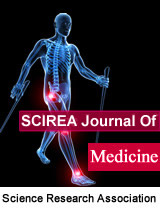Quantitative Relationships Analysis of Structure and Activity of Asam-5-Aryledene-N,N’-dimethylbarbituric Derivatives as an Uric Acid Drug
DOI: 10.54647/pm310205 89 Downloads 115353 Views
Author(s)
Abstract
Objective: This study aims to obtain the best equation model for QSAR which can be used as a gout drug. Quantitative analysis of the structure-activity relationship of 5-aryledene-N,N'-dimethylbarbituric acid derivatives has been carried out as a drug for gout.
Methods: QSAR analysis was performed using the PM3 method using atomic net charge, log P, EHOMO, ELUMO, dipole moment (μ), and polarisabilities (α) as descriptors, followed by analysis using the multilinear regression method.
Results: The results of the QSAR analysis of 5-aryledene-N,N'-dimethylbarbituric acid derivatives which were calculated by the multilinear regression method resulted in 4 models of QSAR equations.
Conclusions: Based on the best QSAR equation model (model 3), there is a selected quantitative relantionship with the most suitable parameters to describe the structural relationship of 5-aryledene-N,N’-dimethylbarbituric acid derivatives on xanthine oxidase inhibitor activity, namely atoms (C2), (N3), (C5), and (C6).
Keywords
Gout, QSAR, 5-Aryledene-N,N’-dimethylbarbituric acid derivatives
Cite this paper
Ruslin Hadanu, Samsia Abd Samad, Muhammad Fath Azzajad,
Quantitative Relationships Analysis of Structure and Activity of Asam-5-Aryledene-N,N’-dimethylbarbituric Derivatives as an Uric Acid Drug
, SCIREA Journal of Medicine.
Volume 7, Issue 2, April 2023 | PP. 15-30.
10.54647/pm310205
References
| [ 1 ] | Fauzi I. Smart book on early detection of symptoms and treatment of gout, diabetes & hypertension. Yogyakarta:Araska; 2014. |
| [ 2 ] | Kertia N. Gout. Yogyakarta: Bentang Pustaka; 2009. |
| [ 3 ] | Choi HK, Mount DB, Reginato AM. Pathogenesis of Gout. American College of Physicians: Internal Medicine. 2005;143(7), 499-516. |
| [ 4 ] | Roddy E and Doherty M. Epidemiology of Gout. 2010; 12(6). http://arthritis-research.com/content/12/6/223. |
| [ 5 ] | Astuti STW and Tjahjono HD. Factors Affecting Levels of Uric Acid (Gout) in Adult Men at RT. 04 RW. 03 New Simomulyo Surabaya. Keperawatan, 2018;3(2), 1-8. |
| [ 6 ] | Cendrianti F, Muslichah S, and Ulfa EU. Antihyperuricemia Activity Test of n-Hexane Extract, Ethyl Acetate, and 70% Ethanol of Tempuyung Leaves (Sonchus arvensis L.) in Hyperuricemia Male Mice. E-Jurnal Pustaka Kesehatan, 2014;2(2), 205-210. |
| [ 7 ] | Saputra L. Pocket Book of Nursing for Patients with Disorders of Cardiovascular Function. South Tangerang: Binarupa Aksara Publisher.2014. |
| [ 8 ] | Khan KM, Khan M, Karim A, et al., 2013. Xanthine Oxidase Inhibition by 5-aryledene N, N’-dimethylbarbituric Acid Derivatives.2014; 23–27. https://www.researchgate.net/ publication/ 236130897. |
| [ 9 ] | Motta LF., Gaudio, AC., and Takahata Y. Quantitative Structure-Activity Relationships of a series of Chalcone Derivatives (1,3-diphenyl-2-propen-1one) as Antiplasmodium falciparum Agents (Anti Malaria Agents), Internet Electron. J. Mol., 2006;5, 555-569. |
| [ 10 ] | Hadanu R. A QSAR Modeling on Aurone Derivatives as Antimalarial Agents, Asian Journal of Chemistry, 2020;32(11), 2839-2845. https://doi.org/10.14233 /ajchem.2020.22846 |
| [ 11 ] | Hadanu R. Modeling of Quinoacridinium Derivatives as Antitumor Agents using a QSAR analysis, Indonesian J Pharm, 2019;30(3), 167-179, DOI: 10.14499/ indonesianjpharm30iss3pp167 indonesianjpharm.farmasi.ugm.ac.id. |
| [ 12 ] | Hadanu R. A QSAR analysis of Flavone Derivatives of Antimalarial Compounds Based on PM3 Semiempirical Method, Asian Journal of Chemistry, 2018; 30(1), 148-156. https://doi.org/10.14233/ajchem.2018.20988. |
| [ 13 ] | Putri DEK, Pranowo HD, Wijaya AR, et al. QSAR Model of 3-4-Substituted Coumarin Derivatives on Pancreatic Anti-cancer Activity, JC-T (Journal Cis-Trans): Journal of Chemistry and Its Applications, 2021;5(1), 13-19. DOI: 10.17977/ um0260v5i12021p013. |
| [ 14 ] | Nurainy NIY. Analysis Quantitative Structure-Activity Relationship (QSAR) of Chalcone Analogue Compounds in Inhibiting MCF 7 Cells, Pharmaceutical World Journal, 2022, 7 (1), 1-13. http://ejournal.helvetia.ac.id/index.php/jdf/article/view/ 5318/1063. |
| [ 15 ] | Suardiani LAK and Kesuma D. Quantitative Relationship of Compound N-(Phenylcarbamothioil)-Benzamide and Its Derivatives to In Silico Anti-Tuberculosis Activity, CERATA Journal of Pharmaceutical Sciences, 2022;13(1), 31-47. https://ejournal.stikesmukla.ac.id /index.php/cerata/article/view/456/219. |
| [ 16 ] | Yeni, Supandi, and Khalishah Y. QSAR and Molecular Binding of Coumarin Derivative Compounds as Anti-Colon Cancer, Bioeduscience, 2018;2(1): 45-52. doi:10.29405/j.bes/45-52121355. |
| [ 17 ] | Widiyanti H, Banon C, and Adfa M. Analysis of Quantitative Structural Relation to the Activity of Cubebin Derivatives as Anticancer Using the Recife Model 1 (RM1) Method, Bencoolen Journal of Pharmacy, 2021;1(1), 46-58. https://ejournal.unib.ac.id/ bjp/article/view/15594/7590. |
| [ 18 ] | Hadanu R, Idris S, and Sutapa IW. QSAR Analysis of Benzothiazole Derivatives of Antimalarial Compounds Based on AM1 Semi-Empirical Method. Indones. J. Chem, 2015;15(1), 86–92. https://jurnal.ugm.ac.id/ijc/article/view/21228/13933. |
| [ 19 ] | Catalani V, Botha M, Corkery JM, et al. The Psychonauts’ Benzodiazepines; Quantitative Structure-Activity Relationship (QSAR) Analysis and Docking Prediction of Their Biological Activity, Pharmaceuticals, 2021;14(720), 1-19. https://doi.org/10.3390/ph14080720. |
| [ 20 ] | Kim JH and Jeong JH. Structure-Activity Relationship Studies Based on 3D-QSAR CoMFA/CoMSIA for Thieno-Pyrimidine Derivatives as Triple Negative Breast Cancer Inhibitors. Molecules, 2022;27(7974),1-21. https://doi.org/10.3390/ molecules27227974. |
| [ 21 ] | Bhujbal SP, Kim H, Bae H, and Hah JM. Design and Synthesis of Aminopyrimidinyl Pyrazole Analogs as PLK1 Inhibitors Using Hybrid 3D-QSAR and Molecular Docking. Pharmaceuticals, 2022; 15(1170), 1-15. https://doi.org/ 10.3390/ph15101170. |
| [ 22 ] | Altaf R, Nadeem H, Iqbal MN, Ilyas U, Ashraf Z, Imran M, and Muhammad SA. Synthesis, Biological Evaluation, 2D-QSAR, and Molecular Simulation Studies of Dihydropyrimidinone Derivatives as Alkaline Phosphatase Inhibitors. CS Omega, 2022; 7( 8), 7139-7154. DOI: 10.1021/acsomega.1c06833. |

